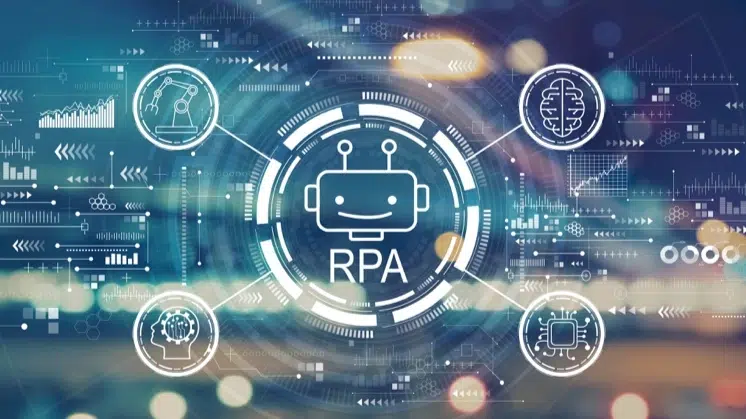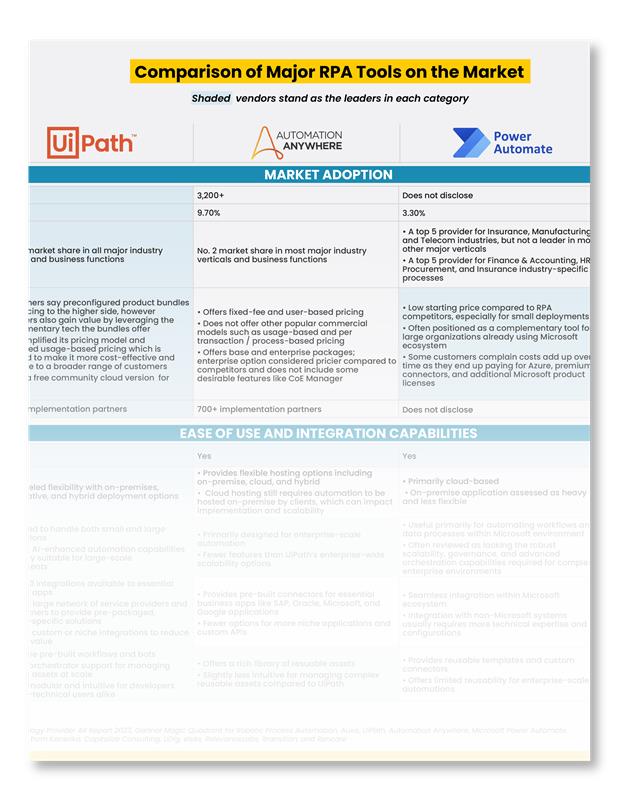Your most valuable assets aren’t your machines or your software; they’re your people. Yet, in nearly every department, these skilled employees are trapped, spending countless hours on repetitive work.
Robotic Process Automation (RPA) is a technology designed to handle these exact tasks with accuracy and speed, 24/7. It allows organizations to automate mundane processes without replacing their legacy systems.
The global RPA market was valued at $22.79 billion in 2024 and is expected to grow rapidly, highlighting the increasing reliance on business process automation. To understand its true impact, let’s explore practical, real-world examples of how implementing RPA tools in core functions can transform your back office.
Finance operations
For finance leaders, speed and accuracy are paramount. RPA delivers significant improvements to core accounting functions, reducing cycle times and freeing the team for value-added analysis.
Accounts payable
A prime example is automating the procure-to-pay (P2P) cycle. Before automation, AP teams spend the majority of their time manually keying in data from hundreds of invoices. This process is not only slow but also highly prone to data entry errors that can lead to incorrect payments.
With RPA, a software robot transforms this workflow. The bot monitors the AP inbox, uses AI to extract data from any invoice format, and performs a three-way match against purchase orders and receipts in the ERP, accelerating cycle times by over 80%.
Accounts receivable
In Accounts Receivable, RPA dramatically accelerates the cash application process. Robots can read bank statements and customer remittance advice, automatically match incoming payments to open invoices in the ERP, and clear the receivables. This reduces the manual effort of matching payments and significantly improves Days Sales Outstanding (DSO).
Financial close & reporting
The benefits are equally significant in the record-to-report (R2R) process. RPA automates the aggregation of data from disparate systems for the month-end close, performs routine balance sheet reconciliations, and even posts standard journal entries. This allows the finance team to focus on analysis rather than data gathering.
Human resources
The administrative burden in HR often detracts from its most important mission: managing and developing talent. RPA automates high-volume, routine tasks across the employee journey, freeing HR professionals to focus on strategic initiatives.
Employee onboarding & offboarding
RPA can transform the employee onboarding process from a manual chore into a seamless, automated workflow. When a new hire’s offer is signed, a single robot can initiate the entire workflow. It can create the employee record in the HRIS, provision user accounts, trigger IT equipment orders, and enroll the new hire in payroll.
Payroll and data management
RPA is also a powerful tool for payroll processing and employee data management. Robots can automate the collection and validation of timesheet data, process payroll calculations, and handle employee status changes or benefits updates across multiple systems, ensuring data integrity and compliance.
Recruitment support
Recruiters spend a significant amount of time on administrative tasks rather than sourcing and engaging candidates. RPA software can assist by automatically screening resumes for keywords and qualifications, scheduling interviews between candidates and hiring managers, and sending out standardized communication, freeing up recruiters to focus on finding top talent.
Customer service
Modern customers expect fast, 24/7, self-service options. RPA helps meet these demands by automating common inquiries and empowering live agents to resolve complex issues more effectively.
24/7 customer self-service & chatbots
RPA-powered chatbots can handle a high volume of front-line customer inquiries around the clock without human intervention. These bots can answer common questions by pulling from a knowledge base, provide product information, check an order’s status, or even process a payment. This provides instant support and deflects simple tickets from the live agent queue.
Empowering agents with real-time data
When a customer does need to speak with a person, RPA ensures the agent is prepared. Attended robots work alongside agents to automatically pull all relevant customer data from the CRM, billing platform, and order systems into a single, unified view the moment an interaction begins. This eliminates manual searches and allows agents to focus on solving the customer’s problem.
Automating backend order and payment processing
An agent’s work often continues after a call ends. RPA can automate the backend fulfillment of customer requests. For example, if a customer places a new order or updates their payment information, a robot can take that data and accurately enter it into all necessary backend systems, eliminating the need for manual after-call work.
IT operations
IT teams are constantly balancing critical infrastructure projects with a high volume of repetitive user-support tickets. RPA automates these low-level tasks, freeing up skilled IT resources for more strategic work.
Help desk and ticket resolution
RPA is a powerful solution for IT help desks that are often overwhelmed by high-volume, repetitive tickets. By integrating with IT Service Management (ITSM) platforms, RPA bots can automate a wide range of common requests—from user access management like password resets to fulfilling standard service requests—freeing up skilled technicians to focus on more strategic projects that drive business value.
User provisioning and account management
Beyond simple tickets, RPA can handle the multi-step process of user provisioning. When a new employee is hired or an existing one changes roles, a robot can execute the entire workflow of creating accounts, assigning permissions, and granting access across dozens of different applications.
System diagnostics and monitoring
RPA can also be used to proactively monitor IT infrastructure health. Bots can be scheduled to perform routine system checks, monitor server performance and application logs, and automatically create and assign incident tickets when a potential issue is detected, helping IT move from a reactive to a proactive support model.
From RPA to intelligent automation
The power of RPA is in handling structured, rules-based tasks that use data from spreadsheets and databases. Its primary limitation, however, is that a significant volume of critical business information is unstructured, found in formats like contracts, invoices, and customer emails.
This is where Intelligent Automation (IA) represents the next evolution. IA enhances standard RPA by integrating Artificial Intelligence (AI) technologies like Machine Learning and Natural Language Processing (NLP).
This integration gives software robots the ability to “read” and “understand” unstructured data. They can now extract specific clauses from a legal document, interpret the sentiment and intent of a customer email, or process invoices in non-standard formats without a template.
This evolution dramatically expands the scope of what can be automated, moving beyond simple, repetitive tasks to complex, end-to-end processes that previously required human judgment. The result is not just greater operational efficiency, but a smarter and more resilient operation.
Why Auxis: Achieve scalable automation and drive real ROI
Deploying and managing a high-performing automation program requires an experienced partner who understands both the technology and business processes. That is why our clients turn to Auxis, a platinum UiPath partner, for a successful digital transformation journey.
We partner with you to redesign processes and build a strategic automation program that aligns with your goals. Our expertise ensures you identify the right opportunities, implement a scalable RPA solution, and free your teams to focus on higher-value work while delivering measurable, long-term results.
Ready to take the next step in RPA implementation initiatives? Schedule a consultation with our automation experts to see how we can transform your business.
Frequently Asked Questions
How does RPA impact existing business systems?
What makes a process a good candidate for RPA?
Is RPA only for large companies?
Does RPA replace human employees?


